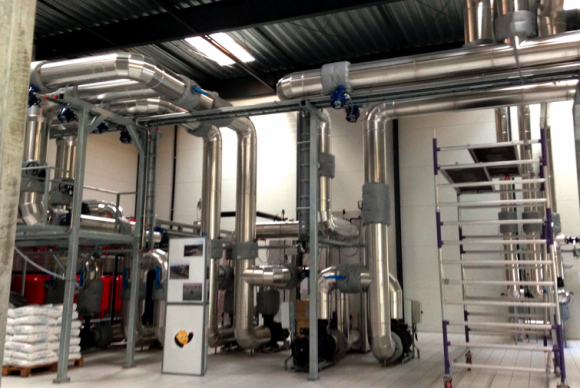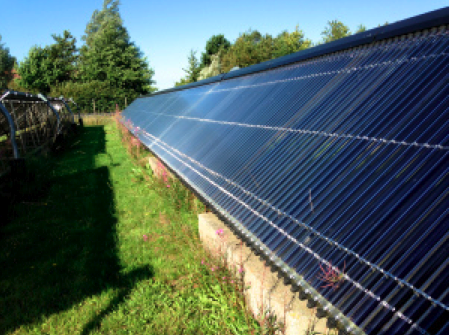
Dispatches from Denmark-Ærø
by: Sarah Vaira Posted on: October 08, 2013
Editor’s Note: Sarah Vaira, a former EarthFix intern, is studying abroad in Copenhagen, Denmark–a world leader in clean energy and environmental planning. She will be sending Read the Dirt dispatches from her adventure. Her first appears below.
It was dark. It was rainy. And I was pedaling through the storm on my bike. I bowed my hooded head forward and bulldozed through the steady wall of raindrops, an unsuccessful undertaking to shield the water from my eyes. I had already come to terms with my journey home from the train station being a cold, thirty-minute shower with all my clothes on; yet I gripped to this feeble attempt to protect myself from the relentless rain.
This wasn’t the first time I had been caught in a small monsoon while returning home from the train station and it was during this ride I celebrated a small victory. After my first soak the previous week, I started carrying around a giant plastic bag to cover my things. I Macgyvered the plastic around my backpack, stretched open two holes and slipped the straps through. This ultimately calmed my anxieties about the rain destroying my laptop in my bag and allowed my mind to wander freely as I pedaled. Copenhagen is located on an island known as ‘Sealand.’ Denmark is made up 407 small islands. Funny, even though I’m living on an island, I feel anything but tropic. A warm, sandy beach would be nice. And maybe a little umbrella drink. I could really use an umbrella right about now–and a drink.
I continued to pedal and arrived home completely drenched, looking as if I had jumped in the ocean and gone surfing, but that clearly wasn’t the case.
…….
Now that I am both dry and recovered from the trauma of being caught in a storm, I don’t crave my tropical getaway anymore. Instead, I think back fondly to the island getaway I did take with my core course, ‘Sustainable Development,’ to the small island of Ærø in Southern Denmark. Although this trip was technically a ‘study tour’ it really felt like a mini vacation–even though it was far from anything tropical.
On this island, sea breezes spin wind turbines and solar collectors arrange themselves like sunbathers on a beach. Historically, Ærø is known for its strong maritime culture, but has recently gained international recognition for its renewable energy initiatives. In 1997, Denmark hosted a renewable energy island competition, and even though Ærø came in second place, the island has set a goal to meet 100% of its energy needs with renewable sources–and is well on their way to accomplishing this. Ærø meets 120% of its electricity needs from 3 wind turbines and 55% of its heating needs from solar and biomass. The most progressive work on Ærø is happening with this heating system, however it is not yet a completely renewable system. In this post I’ll explain how Ærø uses a combination of solar energy and biomass to heat its towns and then evaluate what works in this system and what doesn’t.
Providing heat from solar and biomass is a very simple process. The process starts at Marstal District Heating Plant, which has 18,000 square meters of solar absorbers that are made out of aluminum, glass, and iron. Underneath the metal are pipes with water. The sunlight heats the metal, which heats the water in the pipes. This newly heated water circulates through the plant where it meets another metal sheet for the ‘heat exchange.’ This sheet of metal acts as a barrier between the water from the plant and water used in the homes, but absorbs the heat from the first water source and moves it to the second. The cooled water returns to solar absorbers to be reheated and the extra hot water moves to a storage tank to be used on a cloudy day.
Speaking of bad weather—as I described earlier and experienced myself–Denmark can get dark. So what happens when there’s not enough sun for all the people in Marstal to have hot showers? The plant has a back up plan. Every week, Marstal District Heating receives a shipment of biomass (aka wood chips) that is burned to heat water in a similar way. This biomass is considered a renewable source of energy as the vegetation will grow back in a certain number of years.
Although this system is effective in the sense that it emits a lot less CO2 than traditional heating systems, it is important to note that there are still kinks that need to be worked out. The first is an issue with weather and storage. Denmark only receives sunlight for about half of the year, and when the sun is shining people naturally use less heat, so Marstal ends up with a surplus. While Marstal does have a huge storage tank and pit to save hot water, it cannot store its entire surplus. Furthermore, what is stored is not enough to sustain the heating needs of the community during the second half of the year when there is no sun. This is why biomass is integrated into this system, as it is used when solar is not enough. However, using biomass adds another dimension of complication. On the island of Ærø, and across Denmark in general, forests are not abundant. Small seaside shrubbery is pretty much the extent of the vegetation and this biomass is not worth killing for fuel. Therefore, Marstal imports wood chips from Ukraine. Importing anything requires a lot of oil and gas, which emits tremendous amounts of CO2. Additionally, the employees at Marstal District Heating claim not to know what kind of forestry practices the Ukraine distributor uses. And on top of it all, the rate at which biomass is used for fuel succeeds the rate of growth–this means we are cutting down forests faster than we are replanting them. Biomass is a great alternative to reduce CO2 emissions; however, the supply cannot be sustained at current rates.
So, what does this actually mean? Is Marstal’s system a good example of renewable energy heating? Will this work on a larger scale? Did Ærø stop climate change? If you got bored and scrolled down to catch a summary, here you go: Islands are perfect case studies for testing new energy systems. Islands have smaller populations and the limits to resources and land use are more extreme, which forces people to ‘sustain’ themselves with what they have. The system Marstal developed has great potential, but also has flaws. However, other communities looking to implement renewables into their energy grid can look to islands like Ærø to learn from their successes and challenges. For example, places that receive more consistent sunshine, like California, could use parts of this heating plan and make adjustments for their specific regional needs. Additionally, projects like these require momentum and patience to work through their kinks. One small project cannot fight two centuries worth of greenhouse gas emissions overnight. Instead it is going to take the collaboration of engineers, scientists, politicians, and community members like yourself to solve these problems. Ærø shows us potential, but its up to the rest of us to actualize it.
Articles On Ideas
Ideas: Lessons learned, perspectives, advice and more by and for organizers working toward a more democratic society.
- Sep 26 Education Sneak Peek
- Jun 5 US Climate Movement: Funnel Money Downward if You Want to Survive
- Jan 12 For Teachers and Citizens: How to Respond to Federal Immigration Raids
- Jan 5 How To Respond When Your (Local) Government Gets Sued By A Corporation
- Dec 8 Occupy’s Not So Invisible Work
- Dec 8 Getting Specific About What We Want
- Dec 8 National Sovereignty At Stake
- Dec 8 Lessons Learned By A Federal Enforcer
- Dec 8 Sacred Democracy-The Marriage of the Ethical and the Moral
- Dec 8 A Briefing On The State-Owned Bank of North Dakota
- Nov 8 Politicizing a Social Worker
- Nov 8 Sacred Democracy-Enlightenment and Democracy
- Oct 8 The People Know Best, Should We Listen?
- Oct 8 Sacred Democracy-Democracy: a Work in Progress
- Oct 8 Dispatches from Denmark-Ærø
- Oct 8 Protect The Local Initiative Process-Why Support WA Initiative 517
- Oct 8 Questions for a County Council Could-Be
- Sep 8 A Brief Chat about Workers’ Rights
- Sep 8 Sacred Democracy-Glimmers of Empathy in the Shadows of History
- Aug 8 Native Resilience and Interethnic Cooperation: How Natives are adapting to climate change, and helping their non-Native neighbors follow suit
- Aug 8 Imagining a New Society: Comparisons from Iceland
- Aug 8 Sacred Democracy-Rites of Nature
- Jul 8 Sacred Democracy-The Beatitudes of Fairness
- Jul 8 Speaking With a ‘Fractivist’: Data Acquisition to Federal Exemptions
- Jul 8 Selections from the Public News Service-July 2013 (Audio)
- Jul 8 How the Declaration of Independence got Hijacked
- Jun 10 A Bright Future: Creative, Passionate Students at Class Academy in Portland Participate in Read the Dirt Environmental Writing Contest
- Jun 8 (Audio): Read the Dirt’s Coverage of the 2013 Public Interest Environmental Law Conference
- Jun 8 Sacred Democracy-Living Democracy as Spiritual Practice (Or Vice Versa)
- May 8 Sacred Democracy-The Moral Blueprint
- May 8 Transforming Faith
- Feb 25 Park Rangers to the Rescue
- Feb 11 Washington’s Renewables: An Introduction
- Dec 12 Species Banks
- Nov 23 Our Slaves
- Nov 17 NW Coal Ports: Voice your concerns, voice them loud!
- Nov 13 Meditations on our Future
- Nov 4 Book: Ecoliterate: How Educators Are Cultivating Emotional, Social, and Ecological Intelligence
- Oct 14 Equity, Environmental Justice, and Industrial Pollution in Portland
- Oct 8 Cities advising Counties?
- Sep 12 Talking with Washington State Legislators-Stanford
- Aug 26 Talking with Washington State Legislators-Pollet
- Aug 21 Help! I’m being Climate Changed!
- Jul 14 Questionnaire for the authors of: THE GOLDILOCKS PLANET The 4 Billion Year Story of Earth’s Climate-Oxford University Press
- Jun 17 Can City Planning Make Us Cooler, Healthier and Friendlier?
- Jun 11 The Results-2012
- Mar 25 Making Clean Local Energy Accessible Now (Part 1)
- Mar 8 Our Right To Know
- Jan 18 PROTECT ONLINE FREEDOM—READ THE DIRT DEPENDS ON IT!
- Dec 23 Talking About Our Nuclear Hazard
- Oct 28 Why make Mt. St. Helens a National Park?
- Oct 20 The Story behind the Book, A Great Aridness: Climate Change and the Future of the American Southwest
- Jun 23 McKibben Comments on Expansion of Coal Exports at Cherry Point (Whatcom County)
- Apr 3 WASTED POWER
- Dec 20 Meet Some Environmental Consultants
- Dec 5 Using Dirt to Teach
- Oct 21 The We, The I and The Dirt
- Oct 21 Turning Pollution Into Energy
- Oct 21 Orange and Green
- Oct 21 Election 2010: Talk with a WA State Supreme Court Candidate (Wiggins)
- Oct 21 Election 2010: Talk with a WA State Supreme Court Candidate (Chief Justice Madsen)
- Oct 20 Our Dirty Web Designer (Video)




